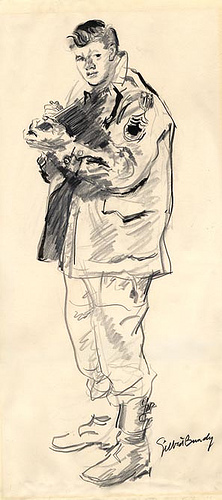--- the drawing of Dad in uniform (see above) is by Gil Bundy, who was a very well-known and respected illustrator. He and Dad were very good friends and went to Korea together to entertain the troops.
Kim.
Early life
Smith was born in Toledo, Ohio. He studied at the Theodore Keane School of Art in Toledo from 1932 to 1936 and at the University of Toledo from 1936 to 1937, receiving an honorary master of arts degree in 1954. He married Mary France Nixon in 1939, with whom he had one son, Richard Keane. Smith's second marriage in 1949 to Ferol Yvonne Stratton produced two girls, Kim and Kathlin Alexandra.
On August 17 the Duck Team proceeded by air to Weihsien, China and after reconnaissance from, their plane located the Civilian Assembly Camp and jumped to begin their mission.
2. They were greeted by the civilian internees who rushed out past the Japanese guards to welcome the parachuting men. Major Staiger immediately made contact with the governing authorities in the camp - the Committee of Nine administrating the ...
Yunnan.
Small Long-coupled horses used to pull two-wheel carts, the Yunnan equivalent to our bus lines.
SIAO HEI'ZE's hair was so thin and fuzzy that he almost didn't look Chinese.
He looked almost blonde. ...
Yunnan.
Small Long-coupled horses used to pull two-wheel carts, the Yunnan equivalent to our bus lines. ...
In picture 007, the nun at left is probably Sister Hiltrudis of St. Joseph School in Tsingtao. The next person, a man with a mustache is certainly Jimmy Baskett of Tsingtao. The next man, in shorts, could very well be Mr. Cockburn, who was our Scout Master, with Father Hanquet and Father Palmers as assistant Scout Masters. If I could get the entire image of the other photos enlarged it is possible I might recognize some more people. I tried, but i could only get a small portion of each picture in the enlarged size.
"Kept in solitary confinement for the duration of the war, suffering from beri-beri and having been horribly beaten by brutal Japanese guards, Barr presented a terrible picture of the atrociousness of war. Greenishly pale, staring vacantly at the broken knuckles of his hands, he was unable to recognize or talk to any one. I was so overwhelmed by the sight that I couldn’t draw, but it was so vivid that I could sketch it today from memory."
The exhibition, free to the public, includes a few of Smith's propaganda illustrations which were created to demoralize Japanese soldiers, but most of the show is devoted to the beautiful, sympathetic drawings and paintings of the people and places he encountered during his tour of duty.



![[click here]](../StanleyFairchild/TN_WilliamSmith.gif)
![[click here]](PhotosSketches/TN_PaintingsSketches.gif)
![[click here]](PhotosSketches/WASmith/TN_TheAuthor.jpg)
![[click here]](TN_KimSmithsBlog.gif)
![[click here]](TN_Wikipedia.gif)
![[click here]](../NormanCliff/liberationDay/DuckMission/TN_DuckMission.jpg)
![[click here]](PhotosSketches/Kunming/TN_Kunming.gif)
![[click here]](PhotosSketches/China_LocalFolks/TN_LocalPopulation.gif)
![[click here]](PhotosSketches/Weihsien_Camp/TN_WeihsienCamp.gif)
![[click here]](PhotosSketches/USA_theArmy/TN_USA_theArmy.gif)
![[click here]](PhotosSketches/Planes/TN_Planes.gif)
![[click here]](PhotosSketches/Japs_theArmy/TN_Army.gif)
![[click here]](PhotosSketches/China_theArmy/TN_TheArmy.gif)
![[click here]](PhotosSketches/Portraits/TN_Portraits.gif)
![[click here]](Links/TN_WilliamSmith_Blog.jpg)
![[click here]](http://weihsien-paintings.org/KimSmith/TN_KimSmithsBlog.gif)